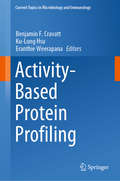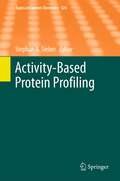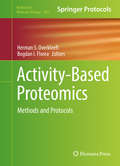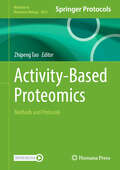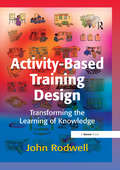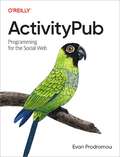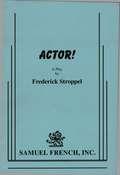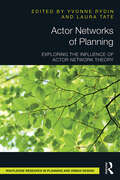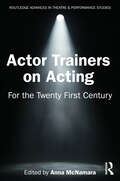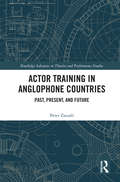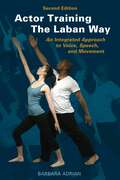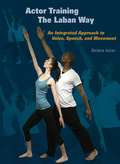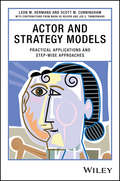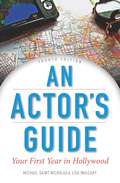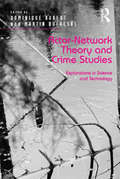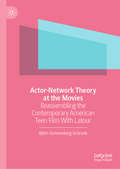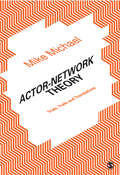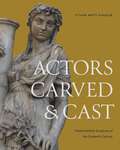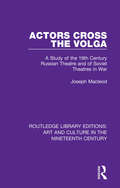- Table View
- List View
Activity-Based Protein Profiling (Current Topics in Microbiology and Immunology #420)
by Benjamin F. Cravatt Ku-Lung Hsu Eranthie WeerapanaThis volume provides a collection of contemporary perspectives on using activity-based protein profiling (ABPP) for biological discoveries in protein science, microbiology, and immunology. A common theme throughout is the special utility of ABPP to interrogate protein function and small-molecule interactions on a global scale in native biological systems. Each chapter showcases distinct advantages of ABPP applied to diverse protein classes and biological systems. As such, the book offers readers valuable insights into the basic principles of ABPP technology and how to apply this approach to biological questions ranging from the study of post-translational modifications to targeting bacterial effectors in host-pathogen interactions.
Activity-Based Protein Profiling (Topics in Current Chemistry #324)
by Stephan A. SieberABPP Methodology: Introduction and Overview, by Matthew B. Nodwell und Stephan A. Sieber Activity-Based Protein Profiling for Natural Product Target Discovery, by Joanna Krysiak und Rolf Breinbauer Photoaffinity Labeling in Activity-Based Protein Profiling, by Paul P. Geurink, Laurette M. Prely, Gijs A. van der Marel, Rainer Bischoff und Herman S. Overkleeft Application of Activity-Based Protein Profiling to the Study of Microbial Pathogenesis, by William P. Heal und Edward W. Tate Functional Analysis of Protein Targets by Metabolomic Approaches, by Yun-Gon Kim und Alan Saghatelian
Activity-Based Proteomics: 9781493964376 (Methods in Molecular Biology #1491)
by Herman S. Overkleeft Bogdan I. FloreaThis volume focuses on explorative activity-based proteomics, biomedical applications of activity-based proteomics, and chemical strategies in activity-based proteomics providing a concise overview of activity-based protein profiling. Written in the highly successful Methods in Molecular Biology series format, chapters include introductions to their respective topics, lists of the necessary materials and reagents, step-by-step, readily reproducible laboratory protocols, and tips on troubleshooting and avoiding known pitfalls.
Activity-Based Proteomics: Methods and Protocols (Methods in Molecular Biology #2921)
by Zhipeng TaoThis volume comprehensively covers techniques that use activity-based proteomics to investigate biological functions of proteins such as lipolytic enzymes, serine hydrolases, chitinases, and glycoside hydrolases. The chapters in this book cover a wide range of protocols and an overview on the application of activity-based proteomics profiling to study deISGylating enzymes, serine hydrolases, monooxygenases, ubiquitin E3 ligases, and reactive cysteine in various organisms, including bacteria, viruses, and mammalian cells and tissues. Furthermore, this book provides updated, comprehensive protocols for utilizing activity-based proteomics profiling to discover new enzymes, detect novel modifications, and identify new drug therapy targets. Written in the highly successful Methods in Molecular Biology series format, chapters include introductions to their respective topics, lists of the necessary materials and reagents, step-by-step, readily reproducible laboratory protocols, and tips on trouble3.shooting and avoiding known pitfalls.Cutting-edge and comprehensive, Activity-Based Proteomics: Methods and Protocols is a valuable resource for all researchers who are interested in applying the latest technologies in this advancing field.
Activity-Based Training Design: Transforming the Learning of Knowledge
by John RodwellActivity-Based Training Design shows you how to design new training sessions or transform existing sessions using tools and techniques that engage the participants, promote the effective learning of knowledge, and are fun to work with. It provides you with active reading techniques like Info Hunt, card-sort activities like Washing Line and ideas for games and activity boards like The Evaluation Game. This is not a set of pre-designed exercises that might or might not be relevant to the training you deliver. This is a set of methods and activities that are aligned with the principles of Accelerated Learning and can be applied to almost any knowledge-based training session. For each activity you will be able to read about how it works, why it works and the purpose and principles behind it. The book also describes how to prepare and run the activity and then provides examples of how the methods have been used on actual training events. Overall, this is a book that provides the tools and techniques for transforming a training session into an accelerated learning activity.
ActivityPub: Programming for the Social Web
by Evan ProdromouActivityPub is the new standard for connecting social networks together on the social web. This open, decentralized social networking protocol defines an API for sharing activities to a social network and a procedure that servers use to distribute those activities to a subscriber's feed. With this book, you'll learn how to assemble ActivityPub-enabled clients for making new kinds of social apps on top of existing networks and build ActivityPub servers that create new human or automated accounts on the social web.With those skills under your belt, you can explore other applications of this publish-subscribe technology: content management systems, internet of things, and enterprise automation. With hands-on examples and in-depth knowledge from Evan Prodromou, one of the authors of the protocol, this is the ActivityPub handbook that every social software hacker needs.Learn what the social web is and what ActivityPub doesRepresent social network data in the Activity Streams 2.0 formatWrite a simple ActivityPub client and serverExtend ActivityPub's functionality with new typesFind in-depth details about the more obscure ActivityPub data structuresEvan Prodromou is a coauthor of the ActivityPub protocol and the Activity Streams 2.0 data format.
Acton: In London And Other Large Cities; With Proposals For The Mitigation And Prevention Of Its Attendant Evils (classic Reprint)
by William ActonPublished in the year 1972, Action: Prostitution Considered is a valuable contribution to the field of History.
Actor
by Frederick StroppelComedy / 3m, 2f / Bare stage with set pieces This comic odyssey charts the life and times of the title character as he makes his way through the show business jungle seeking fame and artistic fulfillment. As a baby he learns that crying brings nourishment and affection; crying too long and loud results in scolds and smacks. Armed with this lesson about the capricious nature of existence, he launches into his craft as a child playing a Wise Man at Christmas. Then it's on to the acting Mecca of New York and acting lessons, a job in children's theatre and the crushing rejection of auditions. He heads to Hollywood and finds success on television and stardom in movies, but his time at the top is fleeting. Throughout, the Actor encounters a bevy of curious characters who influence his journey through this unnatural world.
Actor Networks of Planning: Exploring the Influence of Actor Network Theory
by Yvonne Rydin Laura TatePlanning is centrally focused on places which are significant to people, including both the built and natural environments. In making changes to these places, planning outcomes inevitably benefit some and disadvantage others. It is perhaps surprising that Actor Network Theory (ANT) has only recently been considered as an appropriate lens through which to understand planning practice. This book brings together an international range of contributors to explore such potential of ANT in more detail. While it can be thought of as a subset of complexity theory, given its appreciation for non-linear processes and responses, ANT has its roots in the sociology of scientific and technology studies. ANT now comprises a rich set of concepts that can be applied in research, theoretical and empirical. It is a relational approach that posits a radical symmetry between social and material actors (or actants). It suggests the importance of dynamic processes by which networks of relationships become formed, shift and have effect. And while not inherently normative, ANT has the potential to strengthen other more normative domains of planning theory through its unique analytical lens. However, this requires theoretical and empirical work and the papers in this volume undertake such work. This is the first volume to provide a full consideration of how ANT can contribute to planning studies, and suggests a research agenda for conceptual development and empirical application of the theory.
Actor Trainers on Acting: For the Twenty First Century (Routledge Advances in Theatre & Performance Studies)
by Anna McNamaraActor Trainers on Acting is a comprehensive, diverse and forwardthinking examination of the craft of acting written by leading experts from across the world.The book reflects on the evolving relationship between actor training and the contemporary and future world and considers how directly actor training relates to the living experiences of its stakeholders. Examining the training provider’s role in looking forward to a sustainable and resilient future, this book considers what opportunities there are to be created within performance training and what can be done to enable them. Seeking to provide those teaching, facilitating and leading performance training with ideas and practical steps, this book will be invaluable to students, teachers, practitioners and academics alike.Each chapter features an interview and reflection from leaders drawn from actor training resulting in innovative and insightful individual chapters. The progression is structured to consciously develop the central theme, outlining approaches to contemporary actor training that respond directly to our times globally, building on the foundations of traditions and utilising learning to embolden a confident and resilient training for future students, teachers and industries.
Actor Training
by Alison HodgeActor Training expands on Alison Hodge's highly-acclaimed and best-selling Twentieth Century Actor Training. This exciting second edition radically updates the original book making it even more valuable for any student of the history and practice of actor training. The bibliography is brought right up to date and many chapters are revised. In addition, eight more practitioners are included - and forty more photographs - to create a stunningly comprehensive study. The practitioners included are: Stella Adler; Eugenio Barba; Augusto Boal; Anne Bogart; Bertolt Brecht; Peter Brook; Michael Chekhov; Joseph Chaikin; Jacques Copeau; Philippe Gaulier; Jerzy Grotowski; Maria Knebel; Jacques Lecoq; Joan Littlewood; Sanford Meisner; Vsevolod Meyerhold; Ariane Mnouchkine; Monika Pagneux; Michel Saint-Denis; Włodzimierz Staniewski; Konstantin Stanislavsky; Lee Strasberg The historical, cultural and political context of each practitioner's work is clearly set out by leading experts and accompanied by an incisive and enlightening analysis of the main principles of their training, practical exercises and key productions. This book is an invaluable introduction to the principles and practice of actor training and its role in shaping modern theatre.
Actor Training in Anglophone Countries: Past, Present and Future (Routledge Advances in Theatre & Performance Studies)
by Peter ZazzaliActor Training in Anglophone Countries offers a firsthand account of the most significant acting programs in English-speaking countries throughout the world. The culmination of archival research and fieldwork spanning six years, it is the only work of its kind that studies the history of actor training from an international perspective. It presents the current moment as crucial for student actors and those who teach them. As the profession continues to change, new and progressive approaches to training have become as urgent as they are necessary. Using drama schools and universities as its subjects of inquiry, this book investigates acting programs in the UK, Ireland, the US, Canada, Australia, and New Zealand. Among the case studies are the Royal Academy of Dramatic Art, National Theatre School of Canada, Western Australian Academy of Performing Arts, and Carnegie Mellon University. All recognized for their distinguished reputations by industry professionals and acting teachers alike, the book examines each program’s pedagogical approach, administrative structure, funding apparatus, and alumni success. In doing so, it identifies the challenges facing acting schools today and offers a new direction for training in the twenty-first century. Actor Training in Anglophone Countries will be of interest to theatre and performance scholars, artists, students, and teachers.
Actor Training the Laban Way (Second Edition): An Integrated Approach to Voice, Speech, and Movement
by Barbara AdrianThe Groundbreaking Actor Training Guide, Enhanced with New Videos and Expert Advice from Acting Professionals Actors, teachers, and students of performing arts: sharpen your skills and release your potential with Actor Training the Laban Way, a groundbreaking approach to physical and vocal movement. Utilizing theories of preeminent movement theorist Rudolf Laban, acting teacher and performer Barbara Adrian integrates voice, speech, and movement training with illustrated individual and group exercises that include: Breath Support Building Dynamic Alignment Expanding Vocal Tone and Range Articulation and Rhythmic Exploration Enhancing Strength and Stamina Improving Balance and Flexibility Developing a Relationship to the Environs Revealing Your Emotional State through Physical and Vocal Action This second edition also includes an all-new chapter of advice from acting professionals on how they deploy these exercises and techniques in their acting preparation, practice, and performance. New appendices offer readers links to video supplements as well as exercises in IPA.Actor Training the Laban Way will make any performer more impulsive, imaginative, and expressive.
Actor Training the Laban Way: An Integrated Approach to Voice, Speech, and Movement
by Barbara Adrian* Individual, partner, and group exercises to make any actor more expressive * Crucial acting tips based on the work of distinguished theorist Rudolf Laban * 65 original illustrations of anatomy and warm-up exercises This in-depth, fully illustrated guide offers a groundbreaking approach to understanding physical and vocal movement that will enable readers to discover how to maximize their potential. Packed with practical exercises for individuals, partners, and group work, this book integrates voice, speech, and movement. Exercises for breath support, tone, range, articulation, dynamic alignment, balance, flexibility, strength, and stamina, as well as building relationships, Actor Training the Laban Way is essential reading for all serious actors, acting teachers, and students.
Actor and Strategy Models: Practical Applications and Step-wise Approaches
by Scott W. Cunningham Leon M. HermansA practical how-to guide for more effective planningthrough multi-actor modelling Careful planning is the cornerstone of a successful initiative, and any plan, policy, or business strategy can only be successful if it has the support of different actors. These actors may beactively pursuing their own agendas, so the plan must not only offer an optimal solution to theproblem, but must also fit the needs and abilities of the actors involved. Actor and Strategy Models: Practical Applications and Step-wise Approaches provides a primer on multi-actormodelling, based on the fundamental premise that actor strategies are explained by investigatingwhat actors can do, think, and want to achieve. Covering a variety of models with detailed background and case examples, this book focuses on practical application. Step-by-step instructions for each approach provide immediately actionable insight, while a general framework for actor and strategy modelling allows the reader to tailor any approach as needed to optimize results in terms of situation-specific planning. Oriented toward real-world strategy, this helpful resource: • Provides models that shed light on the multi-actor dimensions of planning, using a variety of analytical approaches • Includes literature, theoretical underpinnings, and applications for each method covered • Clarifies the similarities, differences, and suitable applications between various actor modelling approaches • Provides a step-wise framework for actor and strategy modelling • Offers guidance for the identification, structuring, and measuring of values and perceptions • Examines the challenges involved in analyzing actors and strategies Even before planning begins, an endeavor’s success depends upon a clear understanding of the various actors involved in the planning and implementation stages. From game theory and argumentative analysis, through social network analysis, cognitive mapping, and beyond,Actor and Strategy Models provides valuable insight for more effective planning. Leon M. Hermans is an assistant professor at the Faculty of Technology, Policy, and Management at Delft University of Technology. His research focuses on the use of actor analysis methods to support public policy analysis and evaluation. Scott W. Cunningham is an associate professor at the Faculty of Technology, Policy, and Management at Delft University of Technology. He combines work in actor modelling and game theory with research in data mining, technology forecasting, and innovation.
Actor's Guide: Your First Year in Hollywood
by Lisa Mulcahy Michael St. NicolasFor every actor beginning a career in Hollywood, this indispensable guide will lay out a clear and comprehensible path with tried-and-true advice. Up-to-date resources and new interviews with recently established actors experiencing the current movieland scene--as well as the timeless voices of established actors and industry pros--make this a rich compendium of Hollywood know-how. Delve into the industry with the support from An Actor’s Guide: Your First Year in Hollywood and discover with confidence how to: Find work through a variety of sources Deliver stunning auditions Join SAG-AFTRA Get a great headshot and put together a stunning resume Build your credentials and gain exposure Hone your craft with professional training and classes Snag a top-notch agent Utilize the power of social media From settling into Los Angeles and sticking to a tight budget, to adventures in reality TV and landing the breakthrough parts you came to Hollywood for, any actor eager to learn will get his or her fair share of insider knowledge with this manual and will discover how to create a positive experience while launching an exciting career.
Actor-Network Dramaturgies: The Argentines of Paris (Palgrave Studies in Theatre and Performance History)
by Stefano BoselliThis book provides key critical tools to significantly broaden the readers’ perception of theatre and performance history: in line with posthuman thought, each chapter engages Actor-Network Theory and similar theories to reveal a comprehensive range of human and non-human agents whose collaborations impact theatre productions but are often overlooked. The volume also greatly expands the information available in English on the networks created by several Argentine artists. Through a transnational, transatlantic perspective, case studies refer to the lives, theatre companies, staged productions, and visual artworks of a number of artists who left Buenos Aires during the 1960s due to a mix of personal and political reasons. By establishing themselves in the French capital, queer playwright Copi and directors Jorge Lavelli, Alfredo Arias, and Jérôme Savary, among others, became part of the larger group of intellectuals known as “the Argentines of Paris” and dominated the Parisian theatre scene between the 1980s and 90s. Focusing on these Argentine artists and their nomadic peripeteias, the study thus offers a detailed description of the complexity of agencies and assemblages inextricably involved in theatre productions, including larger historical events, everyday objects, sexual orientation, microbes, and even those agents at work well before a production is conceived.
Actor-Network Theory and Crime Studies: Explorations in Science and Technology
by Dominique Robert Martin DufresneDeveloped by Bruno Latour and his collaborators, actor-network theory (ANT) offers crimes studies a worthy intellectual challenge. It requires us to take the performativity turn, consider the role of objects in our analysis and conceptualize all actants (human and non-human) as relational beings. Thus power is not the property of one party, but rather it is an effect of the relationships among actants. This innovative collection provides a series of empirical and theoretical contributions that shows: ¢ The importance of conceptualizing and analyzing technologies as crucial actants in crime and crime control. ¢ The many facets of ANT: its various uses, its theoretical blending with other approaches, its methodological implications for the field. ¢ The fruitfulness of ANT for studying technologies and crime studies: its potential and limitations for understanding the world and revamping crime studies research goals. Students, academics and policy-makers will benefit from reading this collection in order to explore criminology-related topics in a different way.
Actor-Network Theory and Tourism: Ordering, Materiality and Multiplicity (Contemporary Geographies of Leisure, Tourism and Mobility)
by René van der Duim Carina Ren Gunnar Thór JóhannessonThe recent surfacing of actor-network theory (ANT) in tourism studies correlates to a rising interest in understanding tourism as emergent thorough relational practice connecting cultures, natures and technologies in multifarious ways. Despite the widespread application of ANT across the social sciences, no book has dealt with the practical and theoretical implications of using ANT in Tourism research. This is the first book to critically engage with the use of ANT in tourism studies. By doing so, it challenges approaches that have dominated the literature for the last twenty years and casts new light on issues of materiality, ordering and networks in tourism. The book describes the approach, its possibilities and limitations as an ontology and research methodology, and advances its use and research in the field of tourism.The first three chapters of the book introduce ANT and its key conceptual premises, the book itself and the relation between ANT and tourism studies. Using illustrative cases and examples, the subsequent chapters deal with specific subject areas like materiality, risk, mobilities and ordering and show how ANT contributes to tourism studies. This part presents examples and cases which illustrate the use of the approach in a critical way. Inherently, the study of tourism is a multi-disciplinary field of research and that is reflected in the diverse academic backgrounds of the contributing authors to provide a broad post-disciplinary context of ANT in tourism studies. This unique book, focusing on emerging approaches in tourism research, will be of value to students, researchers and academics in tourism as well as the wider Social Sciences.
Actor-Network Theory at the Movies: Reassembling the Contemporary American Teen Film With Latour
by Björn Sonnenberg-SchrankThis book is one of the first to apply the theoretical tools proposed by French philosopher Bruno Latour to film studies. Through the example of the Hollywood Teen Film and with a particular focus on Actor-Network Theory (ANT), the book delineates how Teen Film has established itself as one of Hollywood’s most consistent and dynamic genres. While many productions may recycle formulaic patterns, there is also a proliferation of cinematic coming-of-age narratives that are aesthetically and politically progressive, experimental, and complex. The case studies develop a Latourian film semiotics as a flexible analytical approach which raises new questions, not only about the history, types and tropes of teen films, but also about their aesthetics, mediality, and composition. Through an exploration of a wide and diverse range of examples from the past decade, including films by female and African-American directors, urban and rural perspectives, and non-heteronormative sexualities, Actor-Network Theory at the Movies demonstrates how the classic Teen Film canon has been regurgitated, expanded, and renewed.
Actor-Network Theory in Education (Education And Social Theory Ser.)
by Richard Edwards Tara FenwickActor-Network Theory (ANT) has enjoyed wide uptake in the social sciences in the past three decades, particularly in science and technology studies, and is increasingly attracting the attention of educational researchers. ANT studies bring to the fore the material – objects of all kinds – and de-centre the human and the social in educational issues. ANT sensibilities are interested in the ways human and non-human elements become interwoven. Since its first introduction, actor-network theory has undergone significant shifts and evolutions and as a result, it is not considered to be a single or coherent theoretical domain, but as developing diversely in response to various challenges. This book offers an introduction to Actor-Network Theory for educators to consider in three ways. One mode is the introduction of concepts, approaches and debates around Actor-Network Theory as a research approach in education. A second mode showcases educational studies that have employed ANT approaches in classrooms, workplaces and community settings, drawn from the UK, USA, Canada, Europe and Australia. These demonstrate how ANT can operate in highly diverse ways whether it focuses on policy critique, curriculum inquiry, engagements with digital media, change and innovation, issues of accountability, or exploring how knowledge unfolds and becomes materialized in various settings. A third mode looks at recent 'after-ANT' inquiries which open an array of important new approaches. Across these diverse environments and uptakes, the authors trace how learning and practice emerge, show what scales are at play, and demonstrate what this means for educational possibilities.
Actor-Network Theory: Trials, Trails and Translations
by Mike MichaelIn this thought-provoking and engaging book, Mike Michael brings us a powerful overview of Actor-Network Theory. Covering a breadth of topics, Michael demonstrates how ANT has become a major theoretical framework, influencing scholarly work across a range of fields. Critical and playful, this book fills a notable gap in the literature as Michael expertly explicates the theory and demonstrates how its key concepts can be applied. Comparing and contrasting ANT with other social scientific perspectives, Michael provides a robust and reflexive account of its analytic and empirical promise. A perfect companion for any student of Science and Technology Studies, Sociology, Geography, Management & Organisation Studies, Media & Communication, and Cultural Studies.
Actor-Network Theory: Trials, Trails and Translations
by Mike MichaelIn this thought-provoking and engaging book, Mike Michael brings us a powerful overview of Actor-Network Theory. Covering a breadth of topics, Michael demonstrates how ANT has become a major theoretical framework, influencing scholarly work across a range of fields. Critical and playful, this book fills a notable gap in the literature as Michael expertly explicates the theory and demonstrates how its key concepts can be applied. Comparing and contrasting ANT with other social scientific perspectives, Michael provides a robust and reflexive account of its analytic and empirical promise. A perfect companion for any student of Science and Technology Studies, Sociology, Geography, Management & Organisation Studies, Media & Communication, and Cultural Studies.
Actors Carved and Cast: Netherlandish Sculpture of the Sixteenth Century
by Ethan Matt KavalerPainting has long dominated discussions of Netherlandish art. Yet in the sixteenth century sculpture was held in considerably higher regard than painting, especially in foreign lands. This beautifully illustrated book is the first comprehensive study of sixteenth-century Netherlandish sculpture, and it opens an important window onto the works and milieu of these artists. Netherlanders dominated the sculptural world of northern Europe. They made the most prestigious tombs and altarpieces, alabaster reliefs, and boxwood collectibles for patrons throughout Iberia, France, and Central Europe. Even in Italy they were a formidable presence; the most famous sculptor in Europe in the second half of the sixteenth century was Giambologna, a Fleming who spent the greater part of his career in Florence. A great many of these artists immigrated to foreign courts—so many that the history of Netherlandish sculpture in the second half of the sixteenth century plays out largely abroad. Netherlandish carvers and casters relocated to what are today Austria, Denmark, England, France, Germany, Italy, Poland, Portugal, Spain, Sweden, and Ukraine. Sculpture, more so than painting, was an essential tool in discourses of power.Offering an essential new perspective on a fascinating period in art history, Actors Carved and Cast will appeal to scholars of sculpture and all those interested in Northern Renaissance art.
Actors Cross the Volga: A Study of the 19th Century Russian Theatre and of Soviet Theatres in War (Routledge Library Editions: Art and Culture in the Nineteenth Century #6)
by Joseph MacleodFirst published in 1946. In this study of Russian theatre, the author explores the developments of drama and the theatre throughout the nineteenth-century. Macleod examines imperial and serf theatres, the impact of Russian drama on the east and west, and the regeneration of theatre at the start of the twentieth-century. This title will be of great interest to students of Theatre Studies and Russian History.
